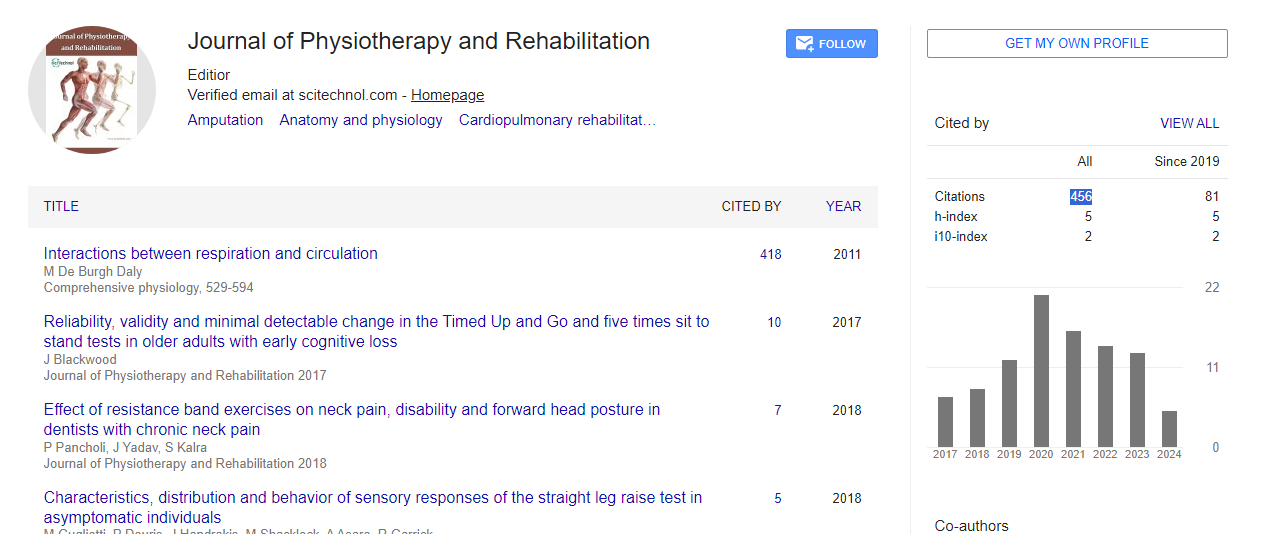Commentary, J Physiother Rehabil Vol: 5 Issue: 12
Review on Geriatric Physical Therapy
Neva Kirk-Sanchez*
Department of Physical Therapy, University of Miami, Coral Gables, Florida
*Corresponding author: Neva Kirk-Sanchez, Department of Physical Therapy, University of Miami, Coral Gables, Florida, E-mail: Neva.Kirk@gmail.com
Received date: 02 December, 2021; Accepted date: 23 December, 2021; Published date: 30 December, 2021
Citation: Sanchez NK (2021) Review on Geriatric Physical Therapy J Physiother Rehabi 5:12.
Abstract
Falls in older adults are a major public health concern due to high prevalence, impact on health outcomes and quality of life, and treatment costs. Physical therapists can play a major role in reducing fall risk for older adults; however, existing Clinical Practice Guidelines (CPGs) related to fall prevention and management are not targeted to physical therapists. The purpose of this Clinical Guidance Statement (CGS) is to provide recommendations to physical therapists to help improve outcomes in the identification and management of fall risk in community-dwelling older adults. The Subcommittee on Evidence-Based Documents of the Practice Committee of the Academy of Geriatric Physical Therapy developed this CGS. Existing CPGs were identified by systematic search and critically appraised using the Appraisal of Guidelines, Research, and Evaluation in Europe II (AGREE II) tool. Through this process, 3 CPGs were recommended for inclusion in the CGS and were synthesized and summarized. Screening recommendations include asking all older adults in contact with a health care provider whether they have fallen in the previous year or have concerns about balance or walking. Follow-up should include screening for balance and mobility impairments. Older adults who screen positive should have a targeted multifactorial assessment and targeted intervention.
Keywords: Geriatric, Clinical Practice, Panel Process
Description
Falls in older adults are a major public health concern due to high prevalence, impact on health outcomes and quality of life, and treatment costs. Physical therapists can play a major role in reducing fall risk for older adults; however, existing Clinical Practice Guidelines (CPGs) related to fall prevention and management are not targeted to physical therapists. The purpose of this Clinical Guidance Statement (CGS) is to provide recommendations to physical therapists to help improve outcomes in the identification and management of fall risk in community-dwelling older adults. The Subcommittee on Evidence-Based Documents of the Practice Committee of the Academy of Geriatric Physical Therapy developed this CGS. Existing CPGs were identified by systematic search and critically appraised using the Appraisal of Guidelines, Research, and Evaluation in Europe II (AGREE II) tool. Through this process, 3 CPGs were recommended for inclusion in the CGS and were synthesized and summarized. Screening recommendations include asking all older adults in contact with a health care provider whether they have fallen in the previous year or have concerns about balance or walking. Follow-up should include screening for balance and mobility impairments. Older adults who screen positive should have a targeted multifactorial assessment and targeted intervention.
Expert Panel Process
The components of this assessment and intervention are reviewed in this CGS, and barriers and issues related to implementation are discussed. A gap analysis supports the need for the development of a physical therapy–specific CPG to provide more precise recommendations for screening and assessment measures, exercise parameters, and delivery models. According to Sackett et al, “Evidence-based medicine is the conscientious, explicit, and judicious use of current best evidence in making decisions about the care of individual patients.
The practice of evidence-based medicine means integrating individual clinical expertise with the best available external clinical evidence from systematic research. Tools for implementing evidence-based practice include documents that synthesize available evidence, such as systematic reviews, and documents that guide decision making, such as Clinical Practice Guidelines (CPGs) and Clinical Guidance Statements (CGSs), also known as clinical practice appraisals. According to the Institute of Medicine, “Clinical practice guidelines are statements that include recommendations intended to optimize patient care that are informed by a systematic review of evidence and an assessment of the benefits and harms of alternative care options. Clinical practice guidelines use strong methodology to guide a systematic review of all available literature to develop statements and recommendations for appropriate health care decisions. In contrast, the CGS systematically compares and synthesizes CPGs of similar topic areas. Key elements of each CGS “include a discussion of areas of agreement and difference, the major recommendations and the corresponding strength of evidence and recommendation rating schemes, and a comparison of guideline methodologies. A caveat is that these CPGs have been developed within the broad context of medical and public health practice. As such, they do not specifically address a physical therapist's clinical decision making, which may cause ambiguity in interpreting existing evidence and applying that evidence to diverse patient populations and needs. Therefore, the overall aim of this project was to create a CGS to guide physical therapist practice using existing CPGs that address falls in community-dwelling older adults.
 Spanish
Spanish  Chinese
Chinese  Russian
Russian  German
German  French
French  Japanese
Japanese  Portuguese
Portuguese  Hindi
Hindi 